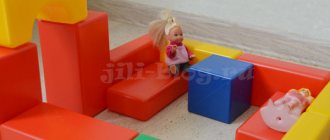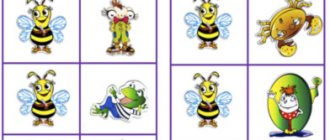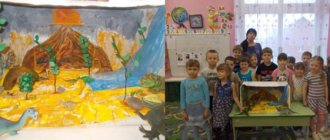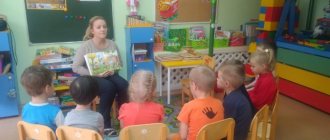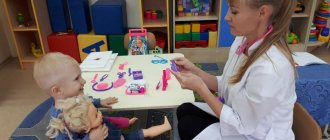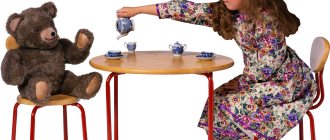What are cards for role-playing games?
Since, as you know, play is the most important method of teaching preschoolers, I try to diversify play moments for children as much as possible, but at the same time, the process should not be spontaneous, as God wills, but orderly and meet the requirements of the Federal State Educational Standard. Didactic materials in kindergarten are a mandatory attribute in the work of a teacher. We accompany every word and gesture with visual aids.
It is no wonder that a separate card index is devoted to such a large layer in educational work as games based on a plot. This could be a folder with inserted cardboard sheets containing information about a specific activity, or a box where it is convenient to store cards.
You can insert each sheet into a file or laminate it to ensure the cards have a long life. In general, this didactic material is a kind of cheat sheet for the teacher. We write down for ourselves all the points that need to be taken into account when organizing children's educational fun.
There are no strict design requirements. But the structure is basically the same: on one side there can be a picture depicting a scene from a story game, on the second side - specific data about the game:
- The name and objectives of the plot game, in other words – the program content;
- Attributes or game material;
- Brief description of the preparatory work: listing thematic poems, stories, conversation topics, possibly excursions, etc.;
- List of expected roles based on the plot of the game;
- Listing possible thematic subplots;
- Brief description of actions during the game.
I write at my convenience, but at the same time I assume that my materials will be viewed by colleagues and management, so I try to do everything beautifully and clearly. In kindergarten, teachers usually either borrow design ideas from others or strive to stand out by doing something exclusive, not like everyone else.
Instead of thematic pictures, you can paste photographs of students during role-playing fun, it will be more interesting, I think. Perhaps some of the readers would like to share their experience of compiling a card index? I will be very grateful!
Internet news from the world of educational and methodological literature
By the way, about the design of the card index. If you have money, but don’t want to bother with cards, you can easily buy ready-made sets based on themes, for example, in UchMag I found cut cards on the theme “Hospital”. Not to say that it’s just pennies, but once in your life you can buy materials and use them throughout your working life.
You can also find cards on the topic of family (a game for children 3-4 years old and older). It will also be convenient for parents to plan their play activities using cards... "UchMag" has also prepared a special educational CD with information on the topic: "Play space as an effective condition for the development of a child", the materials will be of interest to teachers and active parents who want to develop their child according to "the last word of science."
For moms and dads with an active position, I also recommend Natalya Krasnoshchekova’s excellent book “Plot-role-playing games for preschool children.” I believe that such a manual should definitely be not only in the home library, but also on the bedside table for constant study in free minutes.
Another good teaching method is “Plot-based role-playing games for the socialization of children 4-5 years old” from the “Growing up as citizens and patriots” series. Here we present, so to speak, in-depth materials on our topic.
By the way, I forgot to say that these two books can be bought at Labyrinth.ru - a good portal for people who read.
In general, the organization of direct educational activities (DED) in kindergarten is impossible without high-quality didactic materials, which are an indicator of the teacher’s professionalism. As the management says: it’s nice to look at a file cabinet or folders that are orderly, competent, neat, and solid.
Psychologists' opinion
Role-playing games for children represent the last stage in the development of such activities in children - this is confirmed by the psychology of personality development. Until the age of 6 they are the main element of their activity.
As the baby grows, his games develop and improve. So, from simple and primitive plots we very quickly move on to those that cover almost all types of human activity.
Psychologists say that role-playing games play an important role in the psychological development of any child, so they cannot be ignored. Other positive aspects include the following qualities:
- the ability to control your behavioral skills;
- development of voluntary attention;
- proper memory formation;
- character formation.
- monitor your impulsiveness and emotions;
If children's role-playing games are played with peers, they also develop:
- ability to negotiate;
- basics of communication;
- act as a team;
- the ability to defend one’s opinion and negotiate in controversial situations.
During the game, the child plays several roles that can cover various aspects of a person’s life, and at the same time, the active development of mental activity occurs. In such game processes, the child gets used to a unique image, reproduces impressions through his actions, reflects and rethinks his roles. Despite the fact that everything is fictitious, children are more likely to feel a spark of emotions and experiences that enrich their inner world.
Role-playing games for children become relevant for children from the age of two. In this case, the child begins to actively copy the behavior of the adults around him and tries to use objects for their intended purpose or according to their fictitious rules.
What sections should be in the file cabinet of role-playing games?
I’ve written so much about story-based fun for children of different ages that attentive readers can easily list the most popular ones. It is clear that with age the number of stories increases and they become more complex. But the list of fundamental plots for games is practically unchanged for all age groups.
Each general plot, for example, “Family,” for children in the younger group contains a couple of subplots (mom prepares dinner, mom puts the child to bed, dad goes to work, etc.), and for older children this category may include 10 subplots.
I will now list an approximate list of topics for role-playing games that definitely need to be included in the card index, and then I will talk in detail about each category separately:
- Family;
- Shop (supermarket);
- Hospital (polyclinic);
- Kindergarten;
- Hairdresser (beauty salon);
- Cafe;
- Zoo;
- Mail;
- Professions (drivers, builders, sailors, astronauts, etc.)
In the preparatory group, it is logical to add a game to school and traffic rules. Naturally, each teacher adds his own stories at his own discretion, if he has his own good achievements and attributes. But the basic list of games must be worked out in any case, because such games are a child’s path to adulthood.
What generally regulates the choice of these particular themes for role-playing games? If you noticed, the topic covers our most “burning” realities. Sometimes they ask me: why play games with children based on real stories, since children observe our realities every day? For example, if kids attend kindergarten, is it also necessary to play, depicting familiar conditions?
This is the whole point of role-playing games, that it is through playing out everyday situations that children realize their place in the world, learn to interact with other people, and “train” how they will behave in independent life.
What tasks do role-playing games serve?
- Active communication with peers and adults, learning the rules of communication, attentiveness to other participants in the process;
- Developing creative abilities through searching for interesting storylines in the game, coming up with non-standard solutions, selecting attributes;
- Training in self-organization through independent distribution of roles, resolution of conflicts and disputes;
- Developing a sense of tact and respect for comrades;
- Activation of mental activity, ability to analyze and plan one’s actions;
- Identification of various talents, interests, inclinations for expressive reading, acting, etc.;
- Arousing interest in the professions and activities of adults, respect for work;
- Nurturing positive human qualities: empathy, kindness, desire to help;
- Demonstrating a sense of humor and cultivating a friendly attitude towards others’ and one’s own mistakes;
- Increasing children's self-esteem by identifying their talents and abilities in front of the team;
- Fostering a sense of community and uniting children in a group;
- Formation of the ability to use substitute objects in order to develop imagination and non-standard thinking;
- Accustoming to the careful and careful use of toys and handouts;
- Teaching the basics of acting by conveying the character of the role according to the plot;
- Developing discipline skills and the ability to follow the rules of the game established jointly;
- Consolidating a strong interest in role-playing games as the most important way of understanding the world.
But let's return to the card index of role-playing games. Since on each card with the name of the game it is desirable to indicate the goals that the teacher sets for himself when offering children this or that fun, it is quite logical to use the above list of tasks and simply enter some of them, alternating them depending on the direction of the game.
Features of role-playing games depending on the age of the baby
As already mentioned, as the child grows, changes occur in his role-play. Children gain experience as they grow up and try to embody it in this process.
It is important for parents to know and understand at what age a child will be interested in this or that activity; only in this case will you and your child be interested in spending time together.
- Children's role-playing processes for the baby. At 2–3 years old, a child is completely dependent on his parents and draws all information only from their behavior. Therefore, during this period, it is very important for mothers and fathers, grandparents, to support their child in his endeavors.
At this age, the storyline and game situations can be different: from simulating life situations (going to a store, clinic, exhibition) to embodying fairy-tale situations.
If at this time you leave the child without the attention and participation of parents, the pastime will be meaningless and uninteresting for the child.
Try role-playing a trip to the store with your child. At the same time, involve the child in all processes: preparation, selection of goods, purchase and sale, placement of price tags. It is not necessary to use real money. Psychologists say that it is the transformation of objects into something else that perfectly develops a child’s imagination.
- Age of younger groups in kindergarten (3-4 years). During this time, children's role-playing games became especially popular among adult children. With their help, it is easier for a child to find a common language with peers and adapt more easily to a new environment.
At the same time, the child tries new images, fantasizes and finds something new and interesting for himself. At this age, children are interested in playing “hospital” and “family”.
I already know how to assign roles independently. By monitoring children's behavior during play, you can pinpoint children's leadership qualities, or lack thereof, and adjust learning processes over time.
- Preschool age (5-6 years). Here, role-playing games for children become more detailed and developed, and it is the children who make suggestions for their development. At this age, children already have enough skills and abilities to bring the plot of their favorite fairy tale to life.
During this age period, children begin to speak more complex dialogues. At the same time, parents, watching or participating in the role-playing game, continue to closely monitor their child.
What else to read: Consultation for educators “Peculiarities of perception of the size of objects by preschool children,” teacher Manuilova L.M.
At the same time, the child shows his view of the world around him, and an attentive parent always corrects his behavior.
Moms and dads should remember that for them role-playing games with a child is a kind of educational process. Therefore, you should not ignore your, even indirect, participation in this process.
1. What relationships do children reflect in their role-play?
The main activity of preschoolers is play, during which the child’s spiritual and physical strengths develop: his attention, memory, imagination, discipline, dexterity, and so on. In addition, play is a unique way of mastering social experience, characteristic of preschool age.
A special place is occupied by games created by children themselves - they are called creative or story-based role-playing games. In these games, preschoolers play the roles of everything that they see around them in adult life and activity. Creative play more fully shapes a child’s personality and is therefore an important means of education.
The game is a reflection of life. Everything here is “as if”, “fake”, but in this conditional environment, which is created by children’s fantasy, much is present: the actions of the players are always real, their feelings and experiences are sincere, sincere. The child knows that the doll and the bear are just toys, but he loves them as if they were alive, understands that he is not a “good” pilot or sailor, but feels like a brave pilot, a brave sailor who knows how to not be afraid of danger, and is sincerely proud of his victory. Imitating adults in play is associated with the work of the imagination. The child does not copy reality; he combines different life impressions with personal experience.
In the game, children reflect the relationship between the teacher and students.
The theme of the game is the phenomenon of life that will be presented: family, kindergarten, school, travel, holidays. The same theme includes different episodes depending on the interests of children and the development of imagination. This way, you can create different stories on the same topic. Each child portrays a person of a certain profession (teacher, captain, driver) or family member (mother, grandmother). Sometimes the roles of animals and fairy tale characters are played. By creating a play image, the child not only expresses his attitude towards the chosen hero, but also shows personal qualities. All the girls are mothers, but each gives the role its own individual characteristics. Likewise, in the role of a pilot or astronaut, the characteristics of the hero are combined with the characteristics of the child who portrays him. Therefore, the roles may be the same, but the images in the game are always individual.
Numerous observations show that the choice of game is determined by the strength of the child's experience. He feels the need to reflect in the game both everyday impressions associated with the feelings he experiences for loved ones, and unusual events that attract him with their novelty.
The teacher’s task is to help the child choose from the mass of life experiences the most vivid ones, those that can serve as the plot of a good game. The experience of the best teachers convinces us that the only correct way to manage play is to arouse interest in a particular life event and influence the imagination and feelings of children. To make an interesting game, it is not enough for children to simply see how they build a house, transport goods, sew clothes, and so on. The result will be a crappy game with no substance. It is necessary to deeply excite children with life events and people’s work, so that they want to imitate them and experiment with them. A book, a painting, a film, a puppet theater help to accomplish this task.
Glasses have a strong influence on gaming, especially on television, which has become a part of every family's daily life. TV series provide interesting material for games. Many games arise under the influence of special children's programs, as well as programs about events that live in our entire country. Preschool children, like adults, enthusiastically watch programs dedicated to space flights and ask with keen interest about the exploits of astronauts. Like adults, little townspeople are proud of the achievements of our athletes and try to imitate them in their games. The teacher supports these games and helps develop them.
What else to read: What you can play together - an eternal classic that never gets old
Based on the interests of the children and their ideas, the teacher guides the choice of game. Using a variety of techniques, remind children of what they saw and read. For children, for example, visual reminders are important: toys: a toy piano offers a music lesson, toy animals recall a familiar fairy tale. Sometimes, to give children an idea of play, you can show them a puppet show or theater. By repeating the production, the boys are essentially repeating it again, combining what is shown with their personal experience: for example, Doctor Aibolit treats not animals, but dolls sick with the flu.
Young children usually start playing without thinking about the purpose of the game and its content. However, practice shows that already in the fourth year of life, preschoolers can choose the theme of the game and set a specific goal. Before the game starts, the teacher asks: “What will you play? What will you build? Where will you go by train? Who will you be? What toys will you need? These questions get children thinking and charting a storyline that may change in the future. Gradually the game becomes more focused, meaningful, and interesting. At an older preschool age, greater play experience and a more developed imagination help children come up with different interesting stories themselves. The teacher just needs a verbal reminder about the excursion, book, film, so that the idea of a new good game is born. An important stimulus for the game is also a conversation that reveals the meaning of what was seen and read, the characters’ personalities, and their experiences. If you manage to captivate children with the plot, the game will turn out natural even without the teacher’s prompting. But the teacher can also advise the children on the subject of the game if he knows that it will interest them.
If in younger groups it is important only to teach children to consciously choose a game, then with older preschoolers it is necessary to discuss together not only the theme of the game, but also to outline in general terms a plan for the development of the plot, to determine the activities of each of the players. Of course, the game plan can only be indicative; as the plot develops, a lot of new things are introduced, but fantastic
Contents of cards for role-playing games
Now I will talk in detail about what exactly can be written on cards for specific role-playing games. Since the most significant thing in every person’s life is his family, I’ll start with this section of the card index.
Family. A game for children 4-5 years old should not have complex plot lines. It is better to divide a multifaceted concept into subplots and build your work around small plots. I will give examples of subplots, and you choose for each age group of children the ones that are most understandable to them: Morning in my family; Dinner time; How is your weekend? Dad (mom) at work; I got a younger brother (sister); Mom (dad) returns from work; My dad is a builder (driver, fireman, policeman); Mom (father, child) got sick; We clean the house; We help mom wash clothes; We help dad make a stool; We receive guests; We celebrate family holidays; A pet appeared in the house.
These plots are suitable for games in the middle group; younger children should not be offered many sub-plots of the game. We take, for example, “Mom is sick” and “We help mom wash clothes” and conduct a role-playing game.
And for older children, you can give several subplots at once and combine them into one game. So, we wrote the name of the game and wrote out the tasks. Then we indicate the tools - those attributes that are available in the group. Usually these are furniture, dishes, dolls, cars, etc.
Roles: dad, mom, child, maybe grandparents, if mom is sick, then the doctor comes. If you need to go to the pharmacy, you still need a pharmacist.
Preliminary work: conversations on the topic of family, poems, stories (specific names).
Next, we describe the game actions: Mom came home from work and said that she had a sore throat (head, leg, etc.). Dad invites mom to lie down and gives her a thermometer or puts a compress on her leg (head). Then you can call a doctor, you can wash the clothes instead of your mother, cook dinner and bring it to your mother.
In short, we write something like this and bring it to some logical conclusion. For example, my grandmother made medicinal tea for my mother, and my mother’s throat stopped hurting.
Role-playing game "Shop"
A store for children 3-4 years old is a favorite pastime after mothers and daughters, of course. This plot is also divided into subplots by type of store: supermarket, pet store, sporting goods, clothing, etc. Or for the reason why you need to go to the store: we are buying Masha a gift for her birthday, dad needs new shoes, mom is choosing a new dress, Denis wants to buy a parrot, etc.
The objectives of the game are standard, plus you can write about enriching your vocabulary by learning new words.
So let’s write it down: vocabulary – cash register, product, display case, receipt, etc. Instrumentation - whatever we have, we write it down. Remember, I already wrote an article about how to make attributes with your own hands? Here, let's show ingenuity and imagination!
Roles: family members, sellers, buyers, bus or truck drivers. Preliminary work: we read poems, stories, have a conversation, you can go on an excursion to the nearest store. If there are themed board games, we write that down too.
Game activities: Salespeople come to work and prepare for opening by putting goods on shelves. A family travels by bus to a large store to buy groceries for a few days. Shoppers enter grocery aisles, pick up various items and place them in a cart or basket. Then they go to the cash register and pay for their purchases.
The truck delivers a batch of new goods, the driver unloads it and hands it over to the sellers. For the preparatory group, you can come up with a story, like a correspondent comes and asks buyers if they are satisfied with the work of the sellers and the quality of the goods. We end the game with the store closing or the family, having made the necessary purchases, putting them in the car and leaving for home.
Role-playing game “Hospital (clinic)”
Unfortunately, a clinic or hospital is a place where we often visit with preschool children. Possible plots: Bear hurt his paw, Bunny’s ear hurts, we call the doctor home, Little Fox needs to be vaccinated, Mom has a sore throat.
Objectives of the game: developing interest in the medical profession, developing friendly communication skills, developing creative abilities and acting skills, developing speech, and selecting a few more items from my list.
Vocabulary: vaccination, phonendoscope, vitamins, etc. It is clear that for each age group the words correspond to the age.
Instrumentation: everything related to the hospital. I once told you how to make an ENT doctor’s mirror from a CD, and a thermometer from a wooden ice cream stick. But don't forget about substitute items!
I appeal to parents: do not think that using a stick instead of a toy thermometer is the lot of poor children for whom their parents cannot buy toys. The use of substitute objects is an important stage in the formation of imagination, fantasy, and ingenuity. Don’t immediately run to the store if you see how your baby has touchingly adapted caps from plastic bottles into cups and plates for dolls. Let him imagine that these are dishes!
Roles: parents, child, doctor, nurse, ambulance driver.
Preliminary work: as usual, poems, stories, visiting the medical office in the kindergarten, making attributes for the game.
Game actions: everything is like in life. We call a doctor by phone, the nurse applies a bandage, gives an injection, and gives a vaccination. The doctor listens to complaints and writes a prescription.
Corner for playing HOSPITAL
Some of the most popular subjects among children are clinics, hospitals, and dental offices. From childhood, children understand the importance of such a profession as a doctor. Playing hospital is an integral part of children's play time.
As a rule, to organize a corner you need specific furniture: a children's couch and a cabinet with a red cross. If it is not possible to organize a couch, then there must be a locker. What needs to be put there, I think, is not difficult to guess - dummies of medical instruments, jars, cotton wool, bandages and other items that children associate with a hospital. It is also a good idea to prepare forms for prescriptions and prescriptions that your doctor will prescribe. Doctor's kits are sold in any store; purchasing them is not difficult or expensive. Polesye has an excellent and wide selection, from doctor’s trolleys to the simplest and most budget-friendly sets.
Story game “Beauty salon (hair salon)”
Girls love this game very much, and boys act as clients. There is a “Hairdresser” corner in every group, I think, as well as a “Hospital” corner. The principle of filling out cards is the same.
Objectives: to arouse interest in the profession of a hairdresser, to form concepts about men's and women's haircuts, to show the value of work, to expand vocabulary, to cultivate a culture of communication, and so on.
Scenes: mom goes to the hairdresser, we do hair for the New Year's party, dad goes to the men's hairdresser, the stylist does the dolls' hair, etc.
Vocabulary: haircut, styling, hair dryer, master, cape, manicure.
Attributes: everything related to the theme of the game. I once told you what cool sets there are on sale for playing beauty salon. If there are no funds in the group, then at least you can sew a cape and hang a mirror with a shelf. Empty bottles of cosmetics and combs will also work.
Roles: clients, male and female hairdresser, manicurist, cleaning lady.
Preliminary work: conversation on the topic of the hairdresser's profession, reading thematic stories and poems, creating with your own hands attributes for the game and an album of hairstyles. It would be great to go to the nearest hairdresser for a tour.
Game actions: clients come to the salon, sit in a chair and tell the hairdresser what hairstyle they want. Then everything is as we are used to in life: we wash our hair, cut or curl our hair, and dry it. At the same time, we comment on our actions like real masters. The cleaning lady cleans up after a haircut. Clients thank hairdressers.
I describe all the stages purely schematically. Any teacher knows perfectly well how to organize a role-playing game. It’s just that when it comes to filling out cards, I know from my own experience that you somehow get lost and cannot formulate a sentence.
Let's act wisely
If the games of older preschoolers are poor in content, there are two reasons: undeveloped imagination and lack of knowledge. Therefore, the teacher needs to expand children’s ideas about the world around them through reading books, watching cartoons, excursions, and meetings with representatives of different professions.
In order for children to quickly get involved in a new role-playing game, a group is prepared together with them, models of a ship, house, and rocket are created. It is important to set the tone from the very beginning, to offer children an interesting game situation. It is better to give key roles to children with a rich imagination. During games, the teacher should not name the real names of the children; all instructions and comments are made taking into account the chosen plot. He himself soon leaves the game, interfering in two cases:
- When a conflict arises.
- When interest in the game wanes. In this case, you can offer an unexpected plot twist (a huge octopus attacked the ship) or introduce a new character (Baba Yaga comes to the hairdresser).
The task of adults is to prevent role-playing games from disappearing from children’s lives. After all, it is through it that the child’s socialization occurs, imagination develops, and the ability to regulate one’s behavior in accordance with the role played.
How to fill out a card for the game “Farm (zoo)”?
The choice of theme for role-playing games also depends on the area in which the children live. It is better to select stories about what children know. For example, if there is a farm in your village, then play it. It will be clearer for the kids. But the zoo is not suitable for kids who have never been there. They will be confused and will not understand what is required of them. This applies to the younger group.
Older children already know very well about the zoo and the farm, even if they have not seen domestic or wild animals with their own eyes.
So, the objectives of the role-playing game “Farm” are: to introduce children to the animal world, expand their vocabulary, develop warm feelings for pets, and develop the need to care for animals. Learn how to interact while playing. And then choose from the list of tasks already familiar to you.
Vocabulary: domestic and wild animals (names), farmer, veterinarian, livestock pen. Roles: farmer, cattle breeder, veterinarian, tractor driver, pig farmer, livestock breeder, milkmaid.
Preliminary work: reading thematic fiction, watching cartoons about animals, conversations, making attributes for the game. If possible, visit a farm or livestock farm.
Game actions: the farmer and his assistants go to feed the animals in the morning; if the animal is sick, they invite a veterinarian for examination and treatment. The tractor driver brings food to the animals and distributes it to the feeding troughs. Helpers sweep the barnyard and clean up after the animals. Milkmaids pour milk into cans and the tractor driver takes the cans to the shops.
In general, the description of game actions depends on the specific plot chosen.
Nursery group
Young children are just learning to manipulate toys. Organizing a role-playing game is not yet possible, since children do not know how to interact with each other. During the first half of the year, the teacher teaches them to perform simple play actions: rock a doll, roll a car, feed a bear. In this case, substitute objects are actively used: a block instead of an iron, pieces of paper instead of porridge. The games involve the participation of one child or a group of children, each of whom performs the same action.
From the second half of the year, the teacher teaches how to build chains of two or three situations: the doll must be fed, and then rocked to sleep and put to bed. First, he plays out the plot himself in front of the children. Then, after feeding the doll, he asks one of the kids to rock it to sleep, and the other to take it to bed and cover it with a blanket. All actions should be well known to the children from their own experience.
Role-playing game "Cafe"
Kids always eagerly imagine that they are feeding someone, treating someone, or preparing treats. Do you remember how you can make cakes, pizza, dumplings, scrambled eggs from fiberglass, household sponges and napkins? These attributes are perfect for the Cafe game.
Objectives of the game: to introduce children to the features of the profession of a cook, pastry chef, waiter. Instill in children the ability to behave in a public place, place an order, eat carefully, thank the waiter, and show concern for other people. Enrich your vocabulary, teach how to interact in the game, show attention and tact to other children.
Dictionary: service, confectionery, waiter, menu, animator.
Preparatory work: conversations, reading thematic literature, making attributes with your own hands.
Roles: waiters, visitors, cleaning lady, pastry chef (cook), driver, animators.
Game actions: doll Masha invited friends to a children's cafe for her birthday. The toys come to the cafe, they are greeted by animators, given balloons, and entertained. Everyone congratulates Masha and gives gifts. Then everyone sits down at the tables and chooses various delicacies from the menu offered by the waiter.
The waiters bring everything and lay it out beautifully. The dolls eat, don’t forget to carefully wipe their hands with napkins, thank the waiters, and use the cutlery correctly. After eating and dancing, the toys get into a taxi and go home.
I think you understand how to fill out the role play cards, don't you? Everything is simple if you develop a certain algorithm. I did not describe in detail all types of role-playing games; I think you can do everything by analogy.
If you liked the article, please click on the social network icons and show the materials to your friends. The subscription is still valid too!
Sincerely, Tatyana Sukhikh! Till tomorrow!
